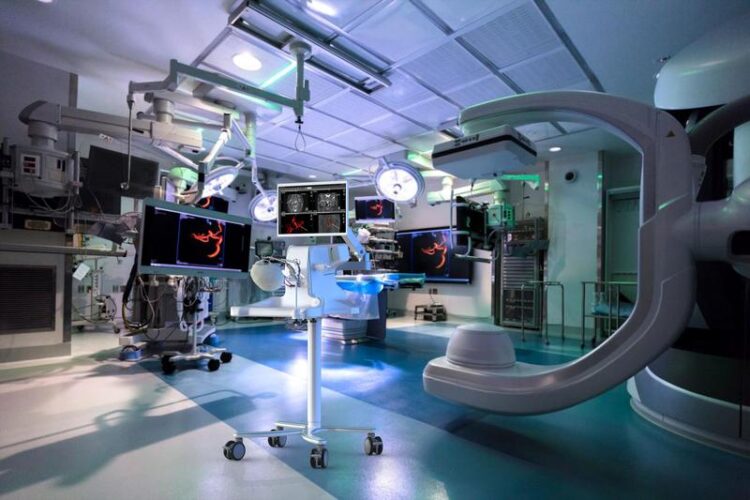4D-Simulator breakthrough in brain surgery

4D surgical simulator in the operation room for planning and training complex brain surgeries
Fredrick Johnson Joseph / SurgeonsLab
Aneurysm operations in the brain rank among the most delicate procedures in neurosurgery. The highest demands are placed on surgeons when choosing the type of intervention, planning the route and carrying out extremely delicate procedures on the blood vessel. A new training technology co-developed between Inselspital, Bern University Hospital, and ARTORG Center of the University of Bern, will further improve patient safety during future procedures: a new 4D simulator enables the planning, testing and optimization of the procedure on an exact 4D model, which also emulates the blood, blood vessels and pulse.
Approximately 2 out of 100 adults have an aneurysm, a balloon-like dilation of a brain artery, very often without feeling or knowing it. Depending on its size and stability, there is a risk that an aneurysm will rupture and cause a cerebral hemorrhage. Neurosurgical treatment of brain aneurysms is challenging because of their unique anatomical features, location and involvement of blood vessels. For this reason, careful consideration of the risk of rupture versus the risks of surgery is necessary. Complications during surgery, although rare, can have far-reaching consequences. Minimizing the risks of surgery is therefore a top priority.
Planning and practicing on the 4D simulator of the actual case
A team of specialists from both the Departments of Neurosurgery and Interventional Neuroradiology at Inselspital and the ARTORG Center of the University of Bern has developed an award winning* 4D simulator technology dedicated to the training of neurosurgical clipping (clamping the aneurysm) and endovascular coiling interventions (filling the aneurysm cavity).
The simulator reproduces the visual and haptic experience of the procedure based on three-dimensional realistic replicas of skull, brain and blood vessels of the patient’s anatomy. In the simulator, the specialists find the precise 1:1 situation that will arise later in the real surgery. This extension to 4D physical simulation is unique worldwide. It accurately models the blood vessels, pulse, blood flow and the temporal aspects of the procedure.
The 4D simulator is used for both planning the actual clipping and coiling procedure and realistic practicing of an actual case. Due to the enhanced planning and pre-op practice, risks of complications will be reduced rigorously.
Informing patients with a 4D model of their own head
Surgical procedures on the brain have a pronounced emotional component for patients. Success of an operation is further facilitated by a positive attitude and the elimination of fears. The 4D-simulation technology allows to educate and explain the entire intervention to a patient in a 1:1 setting to support the patient’s motivation positively.
Training and measurable efficiency thanks to 4D simulator
The 4D simulator also offers new dimensions in the education and training of neurosurgical and neuroradiological specialists. Physicians can gain valuable experience by training on the 4D simulator both during their residency training for the specialist title and during subsequent in-depth courses for specialists. In the context of training, in particular, there is also the possibility of quantifying and comparing the performance of the surgeons themselves. A first course of this kind is planned for summer 2021 in Bern.
Further development with the aid of AI – robotics application as a long-term goal
Dr. David Bervini, (neurosurgeon) and PhD candidate Fredrick Johnson Joseph (biomedical engineer) are to found SurgeonsLab in January 2021. This dynamic start-up will produce and further develop the new 4D-Simulator together with a range of services in training and pre-op innovations in the field of brain surgery. They rely on a high-ranking advisory board and the support of international experts such as Prof. Dr. med. Andreas Raabe and Prof. Dr.-Ing. Stefan Weber. Future development steps will incorporate applications of artificial intelligence (AI) and ultimately robotics.
Wissenschaftliche Ansprechpartner:
Dr. med. David Bervini, neurosurgeon at University Department of Neurosurgery, Inselspital, University Hospital Bern
Fredrick Johnson Joseph, PhD student, ARTORG, Center for Biomedical Engineering Research, University of Bern
Media Contact
All latest news from the category: Medical Engineering
The development of medical equipment, products and technical procedures is characterized by high research and development costs in a variety of fields related to the study of human medicine.
innovations-report provides informative and stimulating reports and articles on topics ranging from imaging processes, cell and tissue techniques, optical techniques, implants, orthopedic aids, clinical and medical office equipment, dialysis systems and x-ray/radiation monitoring devices to endoscopy, ultrasound, surgical techniques, and dental materials.
Newest articles

A universal framework for spatial biology
SpatialData is a freely accessible tool to unify and integrate data from different omics technologies accounting for spatial information, which can provide holistic insights into health and disease. Biological processes…

How complex biological processes arise
A $20 million grant from the U.S. National Science Foundation (NSF) will support the establishment and operation of the National Synthesis Center for Emergence in the Molecular and Cellular Sciences (NCEMS) at…

Airborne single-photon lidar system achieves high-resolution 3D imaging
Compact, low-power system opens doors for photon-efficient drone and satellite-based environmental monitoring and mapping. Researchers have developed a compact and lightweight single-photon airborne lidar system that can acquire high-resolution 3D…





















